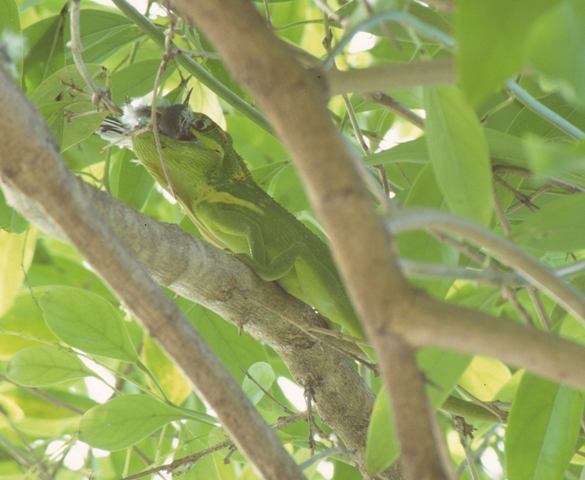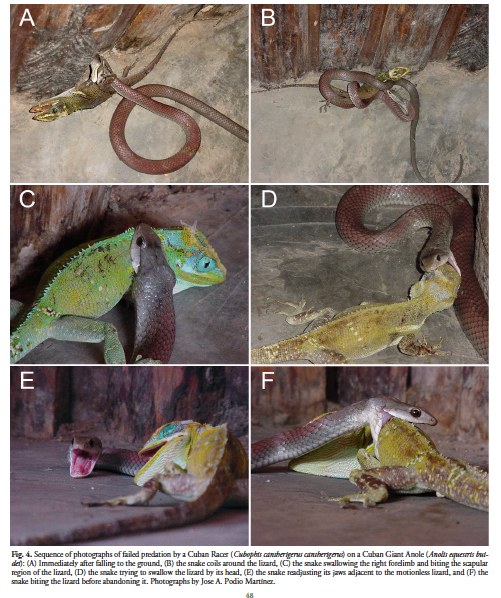Post by Ceratodromeus on Mar 10, 2015 2:03:19 GMT 5

Scientific classification
Kingdom: Animalia
Phylum: Chordata
Class: Reptilia
Order: Squamata
Family: Polychrotidae
Genus: Anolis
Species: Anolis equestris
Description - Also known as the Cuban knight anole, this lizard is the largest of the anolis genus. males are larger then females and can grow to 14 inches, half of which is tail. females are slightly smaller growing to about a foot. there are a few reported individuals reaching the two foot mark, but it appears to represent the maximum boy length of the species. A mass range of 1684 grams was given in The Knight Anole (Anolis equestris) in Florida(Camposano 2008). These anoles are a lime green in color, with various light blue banding coupled with white and yellow speckling. A white stripe can be observed above the shoulder of most individuals. Both males and females sport a reddish-white dewlap. The temperament of these lizards seems to be calmer in captive animals then their wild counterparts. they bite has been described as painful, and these anoles tend to hold on. Aforementioned bite is described as "painful", by those who have been bitten. Like other anole species, A. equestris has been noted to change color in reaction to temperature.
Range - as the alternative common name might indicate, these lizards are native Cuba, but have become widespread in South Florida. There, they are classified as an invasive species. However, they are not seen as a threat to the ecosystem by the department of wildlife.
Behavior - A fairly calm lizard when left unprovoked, this lizard will initially scamper away rapidly if approached, but can and will act out aggresively if agitated. like a lot of lizard species, this anole has its fair share of predators. snakes, larger lizards, frogs, raptorial birds, and felids are all probable predators. They are a very territorial species of lizard, frequently engaging in intraspecific conflicts with one another(Typically males) over territory. These conflicts are often very violent and bloody, as shown by the video below.
They spend the majority of their lives in the trees, spending the majority of the day basking before going to forage amongst the branches. Males have a more extensive home range then the females, but there is typically overlap between the sexes (see Home-range size and overlap within an introduced
population of the Cuban Knight Anole, Anolis equestris (Squamata: Iguanidae); Nicholson and richards 2011)
Diet - Being as large as these lizards are, anything they can fit into their mouths is fair game. They are omnivorous, and have been noted to eat figs and other small fruits in their habitats whenever available.
Animal prey, as listed by Campasano (2008) is as follows:
insects (especially moths, butterflies, and their larvae,
beetles, crickets and grasshoppers, and ants, bees, and wasps),
and small vertebrates such as frogs, lizards (including its own
species), and small birds (Schettino 1999, Schwartz and
Henderson 1991)
beetles, crickets and grasshoppers, and ants, bees, and wasps),
and small vertebrates such as frogs, lizards (including its own
species), and small birds (Schettino 1999, Schwartz and
Henderson 1991)

Reproduction - Copulating pairs are most frequently observed from April through August (Meshaka et al. 2004, Meshaka and Rice 2005). the eggs are small and pearly white; typical clutch size is 1-3 eggs. Neonates typically are <4 cm SVL, and development to sexual maturity (100–110 mm SVL) is rapid in males and females (12–13 months, 8–9 months, respectively) (Meshaka 1999a, Meshaka et al. 2004) When they hatch, they will climb up the nearest amount of vegetation and begin the arboreal lifestyle characteristic of the species.



